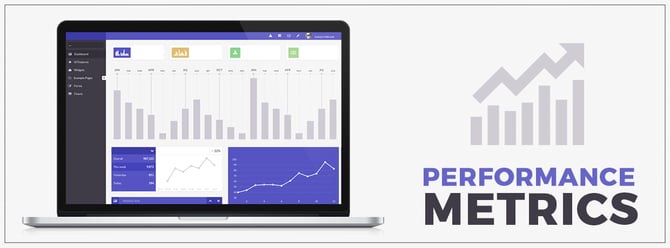Every business process is bound by deadlines, yet too often, these deadlines slip through the cracks. When a process repeatedly falls behind schedule, it's imperative to identify the root causes of this lag and chart a course for improvement. In this blog, tailored for CIOs, we delve into the critical realm of process efficiency. It unravels the intricacies of identifying and rectifying the bottlenecks that impede deadline adherence. Armed with these insights, technology leaders are equipped to champion a culture of punctuality and operational excellence in the digital age

For example, Keith is responsible for an Employee Onboarding process. He has set up the entire process to end no more than three days after the new employee starts. However, the final steps can sometimes happen up to two weeks after the new joinee’s first day. Keith needs a way to look at his process quickly.
What is Process Performance Metrics?
Process Performance Metrics is a tool to spot issues with a process and help enterprises make meaningful decisions to improve processes. The Process Performance Metrics in a business process management system capture process data to allow your process administrator to identify one of two problems:
- The process was not modelled correctly (e.g., unrealistic deadlines).
- Person involved in the process was inefficient (e.g., certain tasks were completed outside the system and not updated)
Process-driven Metrics
Process Performance Metrics overlap closely with Key Performance Indicators (KPIs). Both help a company know if it is achieving expected goals on time. KPIs are studied at a strategic, upper management level, and often times called ‘Strategic Process Performance Metrics’. Process Performance Metrics are integral to BPM systems because they zero in on an individual process at a given time and offer intelligent data.
Let’s go back to Keith’s situation. When he opens up his performance metrics report, he finds that occasionally issuing new ID cards takes substantially longer than it usually does. After drilling down further, he sees that this task often gets queried back to an earlier step.
Keith investigates further and finds that the admin team in charge of issuing ID cards can’t see some of the required data, so they usually have to send it back to HR and wait until they manually receive an email or message with the right information. Keith immediately fixes the problem and makes sure each team has the data it needs.
Finding the Fault in Process
Process performance metrics can be used to reflect and judge a process’s efficiency, evaluate a process owner’s performance, remove wastage in the process, or identify the mean and max time taken to complete a process. Through the use of Process Performance Metrics in a BPM solution, an enterprise can achieve three important goals:
- Define threshold time
- Identify deviations
- Identify top performers
For any business to define a baseline expectation of a process, they should first let it run its natural course and stabilise in order to avoid setting unreasonable deadlines. If a step takes a maximum amount of time, it means there is a deviation in the process and it needs a review. Identifying the most efficient processes and task players helps businesses benchmark other processes at large.
Process Performance Metrics offer great possibilities for companies to improve their process efficiency, and they are extremely important for an organization to create value stream mapping and implement Lean Six Sigma methods.
Are Process Performance Metrics Same As Reports and Analytics?
There is a common tendency to mistake Process Performance Metrics with Reports and Analytics, another very important feature in a business process management tools. However, the two tools are fundamentally different in their approach and objectives.
While Process Performance Metrics capture system data and automatically present the summarised information to the process owners, reports and analytics dwell on user-generated data such as data entered in the form when a task is initiated. Reports and analytics help enterprises make meaningful business decisions, whereas the Process Performance Metrics help managers make decisions to improve existing processes.
For instance, an e-commerce website that receives tons of customer orders for laptops can use reports and analytics to understand which brands of laptops sell the most, and during which months. Understanding customers’ buying patterns helps the company plan their future inventory well.
In the same example, if the company receives a lot of customer complaints about a certain item taking longer than the promised five days to deliver, the management can evaluate the Process Performance Metrics to identify who is the culprit – the inventory team, the packaging and shipping department, or the dispatch team.
As you look for the best business process management software, don’t overlook process performance metrics. They are the heartbeat of continuous improvement and your efforts to improve processes later on will be handicapped without them. Solve your workflow challenges with Kissflow Platform and optimize your team's productivity.
Frequently asked questions
1. Which BPM KPIs matter most to CIOs and operations leaders?
Cycle time, wait-state duration, exception rate, rework frequency, throughput, and SLA adherence.
These KPIs show whether processes are improving in speed and quality.
2. Why is cycle time the first KPI to track?
It reflects total process efficiency from start to finish.
A shorter cycle time usually signals improved routing, fewer delays, and better automation.
3. How do exception KPIs guide improvement priorities?
Exceptions reveal weak rules, unclear inputs, or broken handoffs.
Reducing exception volume improves both speed and compliance.
4. How does throughput KPI support scaling decisions?
Throughput shows how much volume a process can handle reliably.
It helps leaders judge if automation is enabling growth without extra staffing.
5. Why do CIOs track wait-state KPIs separately?
Wait states isolate the exact delay zones inside workflows.
This prevents teams from optimizing irrelevant steps.
6. How should teams avoid KPI vanity metrics?
Don’t track only workflow count or logins.
Track outcomes like time saved, accuracy gains, and reduced escalations.
7. How often should KPI reviews happen?
Continuously for live monitoring, and formally in governance cycles.
Regular review sustains improvements rather than letting performance drift.














